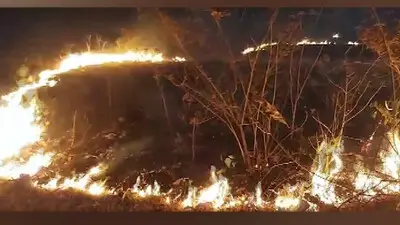Recommended Stories
By Sandeep Sahu
A fortnight after the demolition drive inside a 75-meter radius around the Lord Jagannath temple in Puri began, no one knows what the government proposes to do with the land thus cleared. Will it be a No Man’s Land with only a passage left for devotees to enter the temple? Will part of it be earmarked for parking (presumably by VIPs!)? Or will bunkers be built - with AK 47 wielding commandos manning them - in the space thus vacated (since the government has cited safety and security of the temple as the reason for the demolition)?
With the state government holding the blueprint (assuming that it has one!) tight to its chest, the field has been left wide open for wild speculation of the weirdest kind with a section even suspecting that the government has cut a deal with some party to exploit this valuable land for commercial purposes! The sequence of events since the government stunned everyone with the sudden and unexpected announcement about the demolition drive last month has left plenty of room for such misgivings about the ‘real’ intention behind it. Sample this. Chief Minister Naveen Patnaik announced the comprehensive relief and rehabilitation package for the displaced - described as ‘eye-popping’ in at least one front page headline in a leading Odia daily – on September 1, a full 13 days after the demolition began. And the district collector announced only yesterday – and that too only after the mahants laid seize to the centuries old Bada Akahada mutt to prevent its razing – that he would talks with the latter to break the impasse. Common sense suggests that these things – the announcement of the rehab package and talks with those to be affected – should have preceded the launch of the demolition drive. What exactly was the thinking behind this classic case of putting the cart before the horse?
There are no answers forthcoming from the government on why 75 meters, why not 25/50 or 100/200 meters, either. Who decided on this figure and on what basis? Officially, the government has attributed the demolition to the recommendation of the Justice BP Das Commission. Since the Commission did not recommend clearing the area in the 75-meter periphery of the Meghanada Wall, it is obvious that the government has taken the decision. After the standoff at the Bada Akhada mutt yesterday, Puri collector Balwant Singh said the administration is ‘committed’ to the preservation and redevelopment of these heritage buildings and will soon prepare a ‘road map’ for it in consultation with the mahants and other stakeholders. Are we then to assume that the administration undertook the demolition drive without a ‘road map’ – with or without consultation with the stakeholders?
There are credible reports that an all-powerful ruling party MLA held talks with the mahants and seers in a hotel in the temple town where some kind of an ‘agreement’ was apparently arrived at. The fact that the demolition of the ancient Emar mutt and the Languli mutt went without the kind of protest seen at the Bada Akhada mutt yesterday lends credence to suspicion that a ‘deal’ had indeed been struck. Not many devotees know that the servitors are paid hefty amounts ‘unofficially’ before every Ratha Jatra to ensure that the elaborate rituals connected with the Car Festival go without a hitch. So a similar ‘deal’ in this case is not entirely implausible. But this raises important questions about propriety, transparency (the government’s new buzzword) and constitutional governance. What is the locus standi of the MLA in question to hold talks with those to be affected by the demolition on behalf of the state government? If talks were held, should it not have been conducted by a duly authorized ‘official’ representative of the government – the collector or the Law minister, for example – in full view of TV cameras? Where was the need for the hush-hush manner in which these talks were held? Is it an issue to be settled through ‘back-channel’ or ‘Track II’ diplomacy of the kind we have seen in Indo-Pak relations? If the intentions of the government are noble, why hide it from the public?
The majority of people in Odisha – not just in Puri – are skeptical about the intentions of the government to develop Puri as a world class heritage city – and for good reasons. Had the thousands of crores pumped in by both the Central and state governments through myriad schemes like JNNURM, AMRUT, HRIDAY, ABADHA-1, ABADHA-II and – last but not the least – the ambitious renovation work ahead of the Nabakalebara in 2015 - had actually been spent for the purpose for which such funds were earmarked, Puri would have really undergone a ‘Nabakalebara’ – as was touted before the mega event. But all that money has obviously gone down the bottomless drain and Puri today is no better than it was, say, a decade ago. As we have seen recently, even an hour’s rain can flood the Bada Danda and force commuters to wade through knee-deep – sometimes thigh-deep – water. Drains continue to overflow while other civic services remain what they were – maybe even worse - before the schemes.
One reason for the skepticism is the constant shifting of the goal post by the government. First, it said the demolition had been necessitated by a concern for the safety and security of the Temple, but never bothered to enlighten us on how this will enhance security. When the mahant of the Emar mutt refused to budge, it said the structure was ‘unsafe’. Assuming that it was, was there no way it could have been reconstructed, renovated and restored with the technical knowhow now available? Are parts of the Temple – the Jagamohana, Ratna Bhandar etc - also not ‘unsafe’? Is the ASI not already engaged in restoring them? Why the same could not have been done in the case of heritage buildings like the Emar Mutt and Languli Mutt, which have an umbilical link with the rituals of the Temple and are integral to the whole Jagannath cult? As the protests started gaining momentum, the government came up with a new excuse – encroachment! How did those who bought land from the mutts legally and with the due permission of the municipality and the Endowment commissioner become encroachers overnight? Why does the government not display the same zeal in clearing other encroachments in Puri – at Swargadwara, for example - and elsewhere?
There are far too many questions that beg answers and the government would do well to answer all of them if it really wants to convince those to be affected as well as the people at large that its determination in carrying out the demolition is guided solely by a concern for the safety of the 12th century shrine and nothing else.
(DISCLAIMER: This is an opinion piece. The views expressed are author’s own and have nothing to do with OTV’s charter or views. OTV does not assume any responsibility or liability for the same.)













